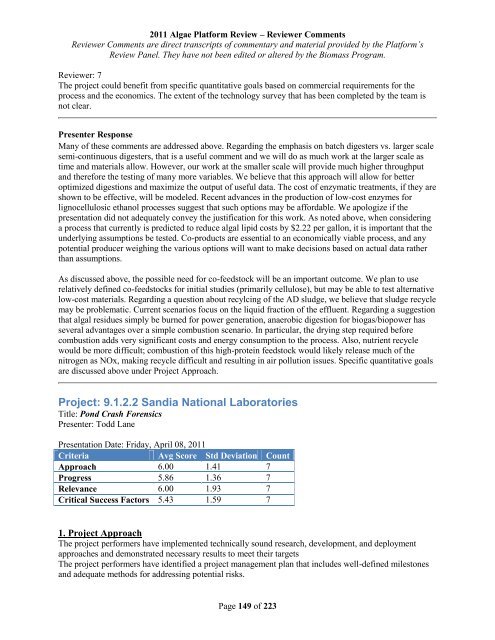Reviewer Comments - EERE
Reviewer Comments - EERE
Reviewer Comments - EERE
Create successful ePaper yourself
Turn your PDF publications into a flip-book with our unique Google optimized e-Paper software.
2011 Algae Platform Review – <strong>Reviewer</strong> <strong>Comments</strong><br />
<strong>Reviewer</strong> <strong>Comments</strong> are direct transcripts of commentary and material provided by the Platform’s<br />
Review Panel. They have not been edited or altered by the Biomass Program.<br />
<strong>Reviewer</strong>: 7<br />
The project could benefit from specific quantitative goals based on commercial requirements for the<br />
process and the economics. The extent of the technology survey that has been completed by the team is<br />
not clear.<br />
Presenter Response<br />
Many of these comments are addressed above. Regarding the emphasis on batch digesters vs. larger scale<br />
semi-continuous digesters, that is a useful comment and we will do as much work at the larger scale as<br />
time and materials allow. However, our work at the smaller scale will provide much higher throughput<br />
and therefore the testing of many more variables. We believe that this approach will allow for better<br />
optimized digestions and maximize the output of useful data. The cost of enzymatic treatments, if they are<br />
shown to be effective, will be modeled. Recent advances in the production of low-cost enzymes for<br />
lignocellulosic ethanol processes suggest that such options may be affordable. We apologize if the<br />
presentation did not adequately convey the justification for this work. As noted above, when considering<br />
a process that currently is predicted to reduce algal lipid costs by $2.22 per gallon, it is important that the<br />
underlying assumptions be tested. Co-products are essential to an economically viable process, and any<br />
potential producer weighing the various options will want to make decisions based on actual data rather<br />
than assumptions.<br />
As discussed above, the possible need for co-feedstock will be an important outcome. We plan to use<br />
relatively defined co-feedstocks for initial studies (primarily cellulose), but may be able to test alternative<br />
low-cost materials. Regarding a question about recylcing of the AD sludge, we believe that sludge recycle<br />
may be problematic. Current scenarios focus on the liquid fraction of the effluent. Regarding a suggestion<br />
that algal residues simply be burned for power generation, anaerobic digestion for biogas/biopower has<br />
several advantages over a simple combustion scenario. In particular, the drying step required before<br />
combustion adds very significant costs and energy consumption to the process. Also, nutrient recycle<br />
would be more difficult; combustion of this high-protein feedstock would likely release much of the<br />
nitrogen as NOx, making recycle difficult and resulting in air pollution issues. Specific quantitative goals<br />
are discussed above under Project Approach.<br />
Project: 9.1.2.2 Sandia National Laboratories<br />
Title: Pond Crash Forensics<br />
Presenter: Todd Lane<br />
Presentation Date: Friday, April 08, 2011<br />
Criteria Avg Score Std Deviation Count<br />
Approach 6.00 1.41 7<br />
Progress 5.86 1.36 7<br />
Relevance 6.00 1.93 7<br />
Critical Success Factors 5.43 1.59 7<br />
1. Project Approach<br />
The project performers have implemented technically sound research, development, and deployment<br />
approaches and demonstrated necessary results to meet their targets<br />
The project performers have identified a project management plan that includes well-defined milestones<br />
and adequate methods for addressing potential risks.<br />
Page 149 of 223




